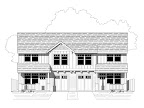- More air goes into a master suite than out;
- This is a result of no escape paths;
- Air backs up into the furnace;
- The furnace gives up and dies during a cold snap.
In order to equalize the air pressure, we need the same amount of air going out of a room as is coming in. The idea is that warm enters a room and forces the cooler air out which goes to the furnace, gets warmed, and the cycle goes again. If air is to leave a room, we need a space for it to happen. There are four common ways to make this happen.
1. Door undercuts have been discussed. These are generally not aesthetically pleasing.
2. High/low relief vents. This entails cutting a hole high up in the wall of the room between studs. Between the same studs a hole is cut near the floor in a hallway or other common area. This allows air pressure to move freely. Grills over both cuts give a more expected appearance. This approach may not give complete privacy as sound can travel a little between both spaces.
3. Jumper ducts in the ceiling. These are leftover pieces of flex duct used to create a connection between bedroom and hallway in the ceiling. It is similar to the high/low vent but less obtrusive and slightly more private.
4. Dedicated return. This is a connection in the ceiling of a room right into the main return for the furnace. This allows for the most direct air balancing and the most privacy. Depending on the distance to the furnace it may be noisy. Further is better.
Bear in mind that these measures are only necessary in larger rooms that can be closed off from the main living area. Smaller bedrooms and bathrooms don't gain enough positive pressure. Great rooms and dining rooms are generally connected to the majority of the living area. A media room or bonus room that is separated by a door and has more than one supply may benefit.
If you want to give it a down and dirty test, close all doors in the house and fire up the blower. Then slowly open each door. If it presents any resistance then some sort of relief is needed. If you want to be even more savvy, get hold of a Duct Blaster and someone who can run one. This will give you an accurate test of where your problems will be. Then whip out your slide rule and estimate a size for pressure relief.
If your house is especially tight, you will definitely want to install a heat recovery ventilator. This system brings fresh outside air into the furnace while tempering it with the heat from outgoing stale air. In some cases this can be your blower with an in-line heat source providing comfort.
Istockhouseplans recommends doing away with ducted systems altogether. For better comfort consider a ductless heat pump, radiant floor heat, or electric soft heat. Or do away with heat sources completely and join the PassivHaus movement.






No comments:
Post a Comment